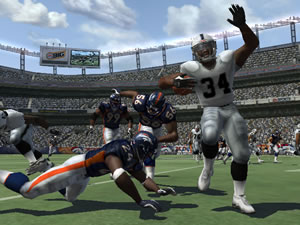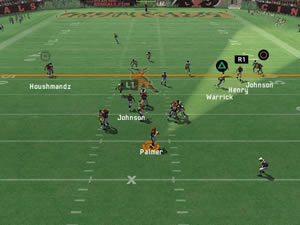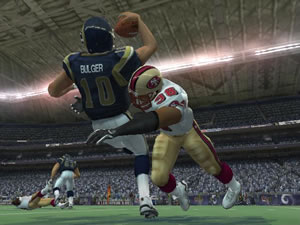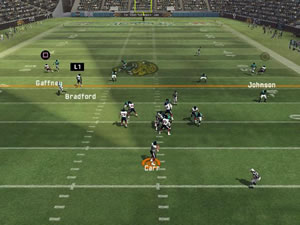The new vision.
Considering the marginal steps previous Madden titles had taken before EA pwned the NFL license, I figured Madden NFL ’06 would basically be the same as last year’s game plus some updated rosters. Why mess with success now that everyone has to buy your product? Why go for the flea-flicker when the game is won?
I don’t know the answer, but I do know that this year EA has taken a greater risk with Madden than any year in recent memory by messing with the passing game. I’ve reviewed a number of Madden games and never complained about the passing scheme. Instead, I’ve bitched about the fact that you could play as Michael Vick and completely dominate defenses by repeatedly running play-action keepers. But that wasn’t a passing issue, that was an A.I. issue unlikely to ever be solved.
Yet this year it has been, thanks to Madden “06‘s daring new take on throwing the ball. Of course, EA managed to slip numerous minor improvements into this iteration as well – just like they did last year and the year before – but it’s mostly all about the air game.
The basics are still intact: you take the snap, drop back and throw the ball by pressing a button that corresponds to a receiver. Now, however, you have to actually look where you’re throwing. This can be accomplished by either moving the R-stick in the desired direction or holding a “Look” button and then locking on to your targeted receiver. The beauty of this system is that defenders – both in game and on the couch next to you – watch your eyes, or in this case, the new Vision Cone.
In turn, you’ll want to look receivers off the ball by following progressions for each play. For example, when the ball is snapped you’ll want to lock-on to a receiver running a deep route while keeping track of the pass rush. If you’re under pressure, you’ll want to quickly look to a dump-off man and pass him the ball, or just throw the thing away. If the pressure gets picked up by your linemen, you’ll want to look short, then quickly look deep and throw a bomb to an open receiver for a big play.
This is essentially how passing in Madden has always worked ” the Vision Cone doesn’t reinvent anything ” but now you have more control over influencing defenders to leave receivers open. You also have more control over your delivery thanks to the effective Precision Passing system. By pressing a direction on the L-stick as you deliver your pass, you can lead or under-throw your receivers as necessary. This isn’t a new idea, but it works well in conjunction with the Vision Cone system. You’ll lock-on to a strong side tight-end running his route, see a weak-side safety cheat over, and then take advantage of his position by quickly switching to a weak-side receiver and leading him to the left, provided the pass-rush doesn’t get to you first. Naturally, the better the QB, the wider the cone. Peyton Manning’s cone takes up roughly half of the field, while Joey Harrington has to make do with a narrow sliver.
Using the Vision Cone correctly is as complicated as it sounds, making Madden 06 a difficult game for novices to wrap their thumbs around. But this new feature’s difficulty and complexity are what make it such a satisfying addition. If you practice and learn your plays, whether novice or veteran, you’ll have more control over your offense than ever before.
While the Cone is the most influential innovation, there are a few small tweaks worth mentioning. A new hot-route allows you to extend any receiver’s pattern to the first-down marker. This is great when you only need to adjust one receiver, but if you need to deal with two or more, there are far too many buttons to press before the play clock runs down. How about an option on the play-calling screen to send everyone to first-down depth?
The new truck-stick adds some oomph to the running game. Players can lower their shoulders and charge by pressing up on the R-stick. This makes running up the middle slightly more viable and stopping goal line pushes even more impossible for the defense.
 There’s also a new formation-specific audible system. Before the snap, pressing the audible button and then up (quick pass), down (run), right (deep pass) or left (play action) on the R-stick will switch the play. If you get the hang of a formation’s quick audibles, you can run a hurry-up and really mess with your friends’ defensive schemes, as well as save yourself time for other adjustments.
There’s also a new formation-specific audible system. Before the snap, pressing the audible button and then up (quick pass), down (run), right (deep pass) or left (play action) on the R-stick will switch the play. If you get the hang of a formation’s quick audibles, you can run a hurry-up and really mess with your friends’ defensive schemes, as well as save yourself time for other adjustments.
While these minor adjustments are welcome, we wish there were a lot more of them. Players still run routes out of bounds instead of toeing the line, you can still drop back 20 yards and heave completions to players you can’t even see, and the blocking A.I. is as atrocious as it’s ever been.
Instead of addressing these issues, EA wasted their time consummating the stillborn Superstar mode. The idea behind this fumble is that you’ll experience several seasons in the NFL as a star, but the whole thing feels so thrown together and pointless that it’s impossible to describe as anything but a complete waste of time and money.
The tragedy begins in your DNA. The first thing you do upon haplessly wandering into this quagmire of mediocrity is choose a mother and father for your star. Basically, two boxes pop up, one for each parent. Each box lists three traits: job, hobby and IQ. Somehow, the particular mix recommends you for a particular position. For example, a sous chef, treasure-hunting father with a 107 IQ plus an adventure-seeking, kayak-loving, 86 IQ mother makes for a great running back. Why? Who knows.
Next, you’re taken to your dingy little apartment and told to consult your schedule. The first event is a meeting with your mentor, Terrell Davis, who says he’s been friends with your dad for years. He’s lying. He’s a gimpy helper-bot, the equivalent to that horrible paper-clip that messes with you every time you install Microsoft Word. Ignore him, he’s washed up.
The next day you have an interview in which you’re asked lame questions like “What do you enjoy eating?” and “What’s more important: fame or fortune?” and you give equally asinine answers. It doesn’t really matter what you say; you won’t suddenly find yourself surrounded in the showers by a pissed off line-backing corps who want to beat some team-spirit into you.
You just go on to the next step – picking an agent. The list is long, but most choices are blocked out since you’re a rookie nobody. Agents have different attributes like Negotiation, Influence and Interview. Great agents will get you more endorsements, movie roles, and access to the Performance Institute, while lesser agents will not get you into the institute and less roles/endorsements. Other than that they send you stupid emails and leave amazing voice-messages like “Great game today!” Show me the door, Maguire.
 While playing through old Madden mini-games (like Rushing Attack) at the Performance Institute boosts your stats, movie roles and endorsements act as the mode’s currency yet are utterly meaningless. When was the last time you saw a football player in a movie? And are endorsements really the most interesting aspects of an NFL player’s off-field life? More specifically, when do the whores and coke enter the picture?
While playing through old Madden mini-games (like Rushing Attack) at the Performance Institute boosts your stats, movie roles and endorsements act as the mode’s currency yet are utterly meaningless. When was the last time you saw a football player in a movie? And are endorsements really the most interesting aspects of an NFL player’s off-field life? More specifically, when do the whores and coke enter the picture?
They don’t, of course. Instead of a hot cup of coffee courtesy of your new agent, you get an IQ test. This affects your character’s awareness, which only matters if your superstar is a Quarterback.
Eventually, you get drafted by a team like the Giants or the Bills. Awesome. That’s April, after which the calendar skips to August and the rest of Superstar mode begins. I’d like to sum this up with creative verbiage, but the only words that come to mind are kaleidoscopic, fragmented, and awful.
Starring in a movie, for example, equates to a line like “I have to get out of here” flashing on the screen. Then, the game asks you to pick the line you just saw from a group of four:
A. You have to get out of here. B. We have to get out of here. C. I have to get out of there. D. I have to get out of here.
Fascinating stuff, huh? Movie roles enhance your player’s Visibility, which is represented by a little meter you can access through your computer. There’s also an Exposure meter that goes up when you issue press releases. If you say something crazy enough (i.e. guarantee a Superbowl win), your Expectations meter will rise. Fail to live up to those Expectations and your Popularity will dive. Filling these meters up is good, and emptying them is bad, although we don’t know why. Since you also make the coaching decisions, it’s not like you’re really going to get mad at yourself for not talking to the other players.
That’s really all there is to it. The “Life’ side of Superstar mode, with its pointless word games, seems a lot more like the life of an old spinster than that of a stud athlete with too much money and not enough emotional maturity.
The other half of the game – the half you actually play – is split between practice sessions and real games. Performing well in the latter makes you popular, and performing well in practices boosts your player’s attributes.
Sounds simple, right? Wrong. You don’t experience this from the perspective of the player, but as the coach. For example, when you decide to practice, you aren’t run through various drills and asked to complete plays by an NPC coach, you’re plopped into regular Madden practice mode…and your player isn’t even on the field. You have to Pause, go to Coaching Decisions (because now you’re the coach, argh), into your depth chart, and replace the starting player with” yourself. Malkovich, malkovich, malkovich!
 This is ridiculous. Practice mode is insanely boring and Superstar mode forces you to play it for hours if you want to develop your player. You can choose to simulate the sessions, but your guy will invariably go out, stink up the practice and lose attribute points. You pretty much have to run at least 300 practice plays before moving on to the regular season.
This is ridiculous. Practice mode is insanely boring and Superstar mode forces you to play it for hours if you want to develop your player. You can choose to simulate the sessions, but your guy will invariably go out, stink up the practice and lose attribute points. You pretty much have to run at least 300 practice plays before moving on to the regular season.
If you make it there before running out of patience, you’ll discover Gameplan practice sessions where the coordinators want you to run certain plays against certain defenses. This is a lot more interesting than calling your own shots, but it isn’t new content, it’s just Practice mode without all the options. It doesn’t feel authentic, either. You should get a briefing from a rendered coach about what the defense is trying to do, who should be open, when, and what to watch out for. Instead you get text to this effect: “The defense is going to run this play, so we’re going to run this other play.”
Why you would deal with any of this instead of switching over to Franchise mode is beyond us. Franchise is basically the same as it was last year, but now you can play Spawn games. Spawning a game essentially means you can create a copy of it to be played at any time for higher scores and better performances. Once you’re satisfied with the result, you can import it back into your Franchise file. This is a neat little idea, if also somewhat cheap.
Aside from Superstar mode and Spawn games, Madden NFL 06 has the same off-the-field features as Madden NFL 2005. You can still create fans, players, teams and playbooks, Franchise is still deep and it’s still easy to jump online and play single games or create tournaments. For detailed descriptions of these features, check out last year’s review. For real.
The differences between the three console versions are largely the same as they’ve always been. Control in the PS2 version is relatively smoother thanks to the extra shoulder buttons, the Xbox version loads much faster than the rest, and the Gamecube version isn’t playable online.
The Xbox version also looks better than the rest and almost never slows down, and all are subject to weird graphical glitches like flickering players. While the Vision Cone looks cool, this year’s game seems slightly less polished than last year’s, especially on the PS2 which occasionally experiences some strong framerate hiccups.
Thankfully, the game’s music, commentary and sound effects don’t suffer from any noticeable glitches, but once again Madden occasionally seems to suffer from mental retardation and the soundtrack smacks of bad taste.
While EA’s gridiron grit in the face of certain victory is pleasantly surprising, their clock-managements skills could still use some work. Why they let themselves waste so much effort on a mode attempting to equate practice and multiple-choice questions with the life of a star is a mystery. I mean, is T.O. known for his great practice attendance? Does Jamal Lewis give predetermined answers to predetermined questions? Yes, officer? At least the game makes you feel more like a quarterback than ever before, and that’s reason enough for one hell of an end-zone celebration.
-
Hardcore vision system
-
Some minor tweaks
-
Tons of content...
-
...almost all of which is old
-
Superstar mode is terrible







